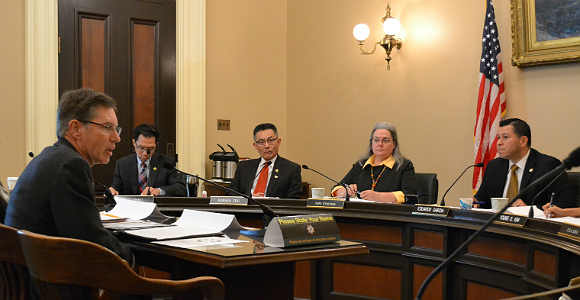
CA Fwd President and CEO Jim Mayer addresses the Assembly Committee on Jobs, Economic Development, and the Economy. (Photo Credit: Phil Ung)
|
FOR IMMEDIATE RELEASE |
CONTACT: Toni Symonds 916.319.2090 toni.symonds@asm.ca.gov |
California Economy at a Crossroads:
Does California have the Right Mix of Economic and Workforce Policies and Programs?
SACRAMENTO – Assemblymember Eduardo Garcia (D-Coachella), chair of the Assembly Committee on Jobs, Economic Development, and the Economy (JEDE) held the second in a two-part series of hearings on the California economy. Representatives of the state’s labor, workforce training, and economic development agencies testified along with representatives of the California Economic Summit and the manufacturing industry about the importance of aligning state efforts to expand the state’s economic recovery.
“Given the ever changing global economy,” said Garcia, “It is important that we consistently evaluate whether California has the right mix of policies and programs to help business and workers be competitive in the post-recession global economy, “Garcia said. “Our goal is to help create the conditions that support America’s entrepreneurial spirit.”
Some key findings from the hearing:
- California created more jobs in 2014 than any other state – 498,000, according to newly released numbers from the U.S. Bureau of Labor Statistics
- The new California Competes Tax Credit has distributed $60 million to 85 companies in the last two years, creating 10,000 jobs and $3 billion in investment
- California needs 1 million more community college graduates to fill job openings in the state between now and 2025
- California manufacturers continue to make investments in the state, despite high energy costs and regulatory uncertainty. Many industry leaders approve of the state’s expansive climate policies and environmental standards and seek only streamlined permitting processes to achieve climate goals while also growing jobs.
Among other topics, presentations outlined the Governor’s $1.2 billion workforce initiative, provided an update on the California Community College’s Task Force on Workforce, Job Creation and a Strong Economy, and the Roadmap to Shared Prosperity developed through the California Economic Summit.
In the hearing, remarkable alignment was evident between leaders of public and private workforce and economic development initiatives focused on widening pathways to middle-class jobs and growing California businesses. Speakers included representatives from the California Labor Agency, California Workforce Investment Board, the California Community College Chancellor’s Office, and the Governor’s Office of Business & Economic Development (GO-Biz), as well as the California Manufacturing Technology Association.
“There is clearly a great deal of enthusiasm from state leaders to ensure the short-term recovery leads to long-term prosperity—and sustainable job growth in every region,” said Jim Mayer, president and CEO of California Forward, one of the lead organizations involved in the California Economic Summit, a growing coalition of public- and private-sector leaders committed to accelerating middle-class job growth in every region. “Today’s testimony showed just how much we’re beginning to see the importance of tailoring state programs to meet the needs of regional economies—and braiding funding streams to build better connections between workforce and industry.”
Members were briefed on several major initiatives already underway, posing questions about how the Legislature could sharpen its economic development strategies—from creating an integrated education and workforce development system that supports dominant and emerging industries to the tax credits, affordable housing, and streamlined permitting that will allow the economy to grow.
“To take on the challenges California regions face—expanding income inequality, rising poverty, and the challenges of climate change—the state will need to adopt a comprehensive approach,” said Paul Granillo, president and CEO of the Inland Empire Economic Partnership and one of the co-chairs of the California Economic Summit. “I was heartened to see committee members demonstrating real interest in this. The economic recovery is expanding, but there are parts of California where the path to prosperity isn’t always clear—like the Inland Empire, where nearly a million people are living in poverty and where less than one in five people have a college degree. To take on these issues, we can’t treat economic development and housing and transportation and workforce as separate issues. We need to bring the public and private sector together to make progress on all of them at the same time.”
More information about the hearing is available at http://ajed.assembly.ca.gov/ including a full list of witnesses, a background paper, and fact sheets.

